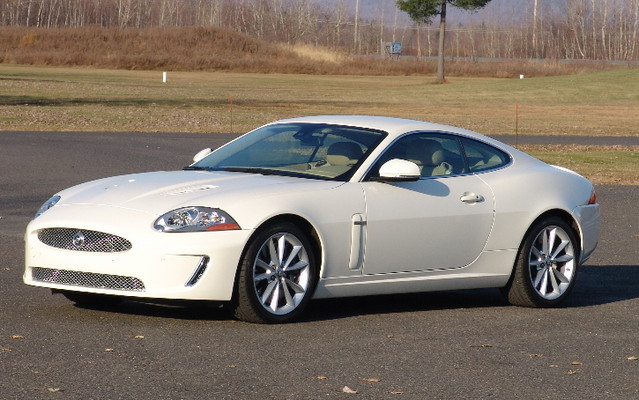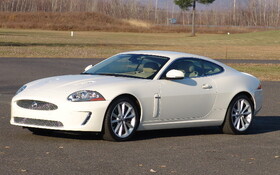The Jaguar XKR: The cat is out of the bag

| Strong points |
|
|---|---|
| Weak points |
|
Since its career began in 1920, the Jaguar brand has had moments of glory and moments of difficulty. Some 20 years ago, the noble English brand was bought by Ford, which was in expansion-mode at the time. Ironically, even though British dignity is about the last thing Americans could understand, Jaguar survived. In a 2008 restructuring effort, the company from Coventry, located about 160 km north-west of London, was acquired by India’s Tata Motors.
Nonetheless, in 1997, then still under Ford, they launched a superb coupe and an even more superb cabriolet, the XK8. Ten years later, the new generation of this duo was introduced. And once again, Jaguar charmed the public with its power and personality.
More than a gentle purr...
Last fall, we had the pleasure of testing a XKR coupe. Now, the base model (!) of both the coupe and cabriolet comes with a 5.0-litre V8 delivering 385 hp and 380 lbs-ft of torque, and the R, with its supercharged engine, adds an additional 125 hp and 81 lbs-ft of torque available from 2,500-5,500 rpm. So yeah, the XKR is über-powerful. According to Jaguar, it goes from 0-100 km/hr in 4.6 seconds, but AJAC (Automobile Journalists Association of Canada) says it’s more like 5.1, which is still not bad... This engine, as well as its non-supercharged counterpart, benefits from fuel-injection. And as for the way it sounds during accelerations, it absolutely thrilled my ears, which are genetically predisposed to love big American cars.
Regardless of the engine you choose, the XKR comes with a six-speed automatic ZF transmission. Very well spaced, the gears are quick to shift up or down. A pop-up button controls the gearbox, which means that when not in use, it stays pushed into the central console. It not only looks good, but it’s easy to use with the button popping up as soon as you turn the key in the ignition. The transmission comes with a Sport mode, which noticeably increases the engine revs. For example, at 100 km/hr, the engine goes from 1,800 to 3,000 rpm, which translates into punchier (or should I say "even punchier") accelerations when coming out of curves. In Sport mode, you can also use the paddles behind the steering wheel to change gears.
The R models post 14.1 litres/100 km in the city and 9.1 on the highway. After our week-long test drive, the onboard computer had calculated 14.0 litres. But, of course, you have to congratulate the driver for that... Because if you abuse it even just a little, this car could easily guzzle 16 or 17 litres/ 100 km of super. And by abuse, I don’t mean a few virile accelerations here and there, or a few drifts in safe places... Indeed, you can deactivate all driver-assist systems, but it’s strongly recommended that you do it on the track. A very talented journalist (yours truly) allowed himself to do a swing-around in an empty parking lot; and believe me, that back end can take off on you pretty easily. Go easy on the accelerator, though, and you can put a pretty sweet swagger into its rear.
Comfortable, despite it all
The steering proved to be very precise and offered good feedback. However, it becomes really stiff when you change lanes quickly. An electronic steering would be welcome! Obviously, the brakes are very powerful, despite the ABS which could be a little more discreet. As for the suspension, which is attached to a rather difficult chassis, it contributes to good handling while remaining relatively comfortable. On poor roads, however, you’ll feel those holes and bumps. There are Dunlop SP Sport 245/40ZR19 tires in front and 275/35ZR19 tires in the back. With their low profile and wide belt, they are partly to blame for bouncing the passengers about, but we forgive them since they do such a good job adhering to the asphalt.
Thrown into a curve à la "1992 pimped Civic driven by a teenager," the XKR shows its stubborn stripes. Well balanced and featuring sophisticated electronic systems that kick in at just the right moment (i.e. not too late), this wildcat is one of the most fun cars to drive.
Tradition meets modernity
Even though it’s a sport coupe, the interior is far from Spartan and the dash is a lot better laid out that the one in the BMW 6-Series (for example). I would not, however, go so far as saying that the lay-out is perfectly ergonomical – proven by the swear words that escaped the first time I used the sound system. Also, there are some rather vulgar Ford controls on board (the windshield-wiper and turn-signal levers, among others), which overshadow the excellent quality of the materials. Curiously for a sport vehicle, the visibility is excellent... except looking back, where it is truly awful. And there’s no back-up camera. In addition, the windshield has some very thin heating wires that, while they may perform miracles in winter (who in their right mind would take this car out in the snow???) create some glare in the sun. Finding a good driving position is fast, and the very comfortable seats hug you well in turns. In the spirit of "speak no evil," I’ll refrain from mentioning the back seats, which are absolutely ridiculous and totally uncomfortable. The hatch opens wide into a good-sized trunk with a low loading height.
From many points of view, the XKR is a success. However , we’d be remiss if we did not mention its pitiful reputation in terms of reliability. It is improving, and Jaguar now sits 23rd among 36 brands with regard to general reliability, according to J.D. Power. Just think of what it was like before! Powerful and snazzy, this Brit is not a hard-and-fast sports car. It’s more of a GT, like the BMW 6-Series, Mercedes-Benz SL-Class and some Aston Martin Vantages. In fact, even if it can hold its own on the racetrack, its weight makes it less agile than a true sports car. This car strongly prefers the long and lovely German Autobahn. Priced at $107,000 (as opposed to $96,500 for the XK and $114,000 for the XKR cabriolet), it’s expensive, but that’s what the thrill of exclusivity costs.











